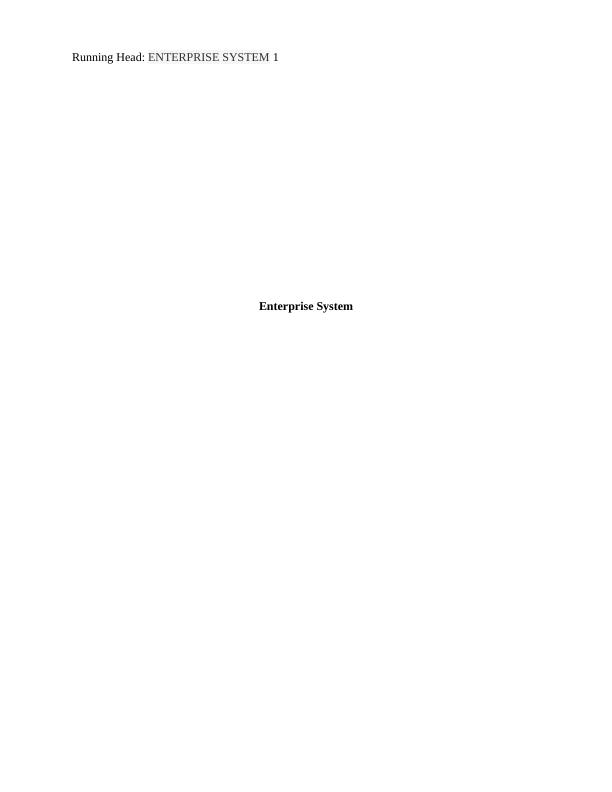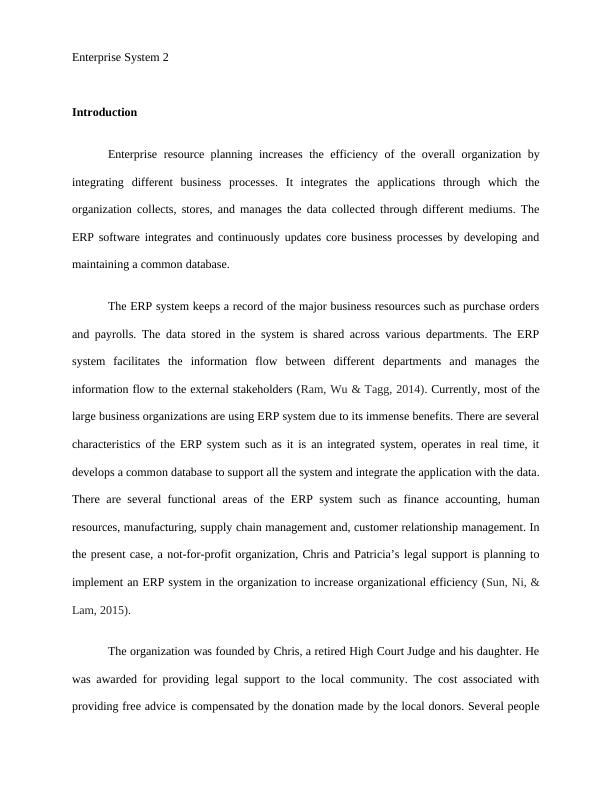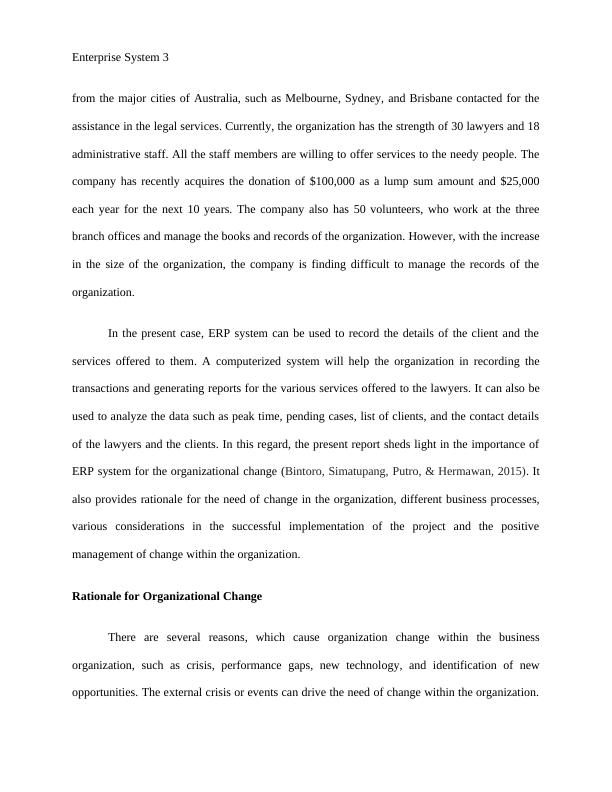Enterprise Resource Planning System
14 Pages3577 Words42 Views
Added on 2020-05-28
Enterprise Resource Planning System
Added on 2020-05-28
ShareRelated Documents
Running Head: ENTERPRISE SYSTEM1Enterprise System

Enterprise System 2Introduction Enterprise resource planning increases the efficiency of the overall organization byintegrating different business processes. It integrates the applications through which theorganization collects, stores, and manages the data collected through different mediums. TheERP software integrates and continuously updates core business processes by developing andmaintaining a common database. The ERP system keeps a record of the major business resources such as purchase ordersand payrolls. The data stored in the system is shared across various departments. The ERPsystem facilitates the information flow between different departments and manages theinformation flow to the external stakeholders (Ram, Wu & Tagg, 2014). Currently, most of thelarge business organizations are using ERP system due to its immense benefits. There are severalcharacteristics of the ERP system such as it is an integrated system, operates in real time, itdevelops a common database to support all the system and integrate the application with the data.There are several functional areas of the ERP system such as finance accounting, humanresources, manufacturing, supply chain management and, customer relationship management. Inthe present case, a not-for-profit organization, Chris and Patricia’s legal support is planning toimplement an ERP system in the organization to increase organizational efficiency (Sun, Ni, &Lam, 2015). The organization was founded by Chris, a retired High Court Judge and his daughter. Hewas awarded for providing legal support to the local community. The cost associated withproviding free advice is compensated by the donation made by the local donors. Several people

Enterprise System 3from the major cities of Australia, such as Melbourne, Sydney, and Brisbane contacted for theassistance in the legal services. Currently, the organization has the strength of 30 lawyers and 18administrative staff. All the staff members are willing to offer services to the needy people. Thecompany has recently acquires the donation of $100,000 as a lump sum amount and $25,000each year for the next 10 years. The company also has 50 volunteers, who work at the threebranch offices and manage the books and records of the organization. However, with the increasein the size of the organization, the company is finding difficult to manage the records of theorganization. In the present case, ERP system can be used to record the details of the client and theservices offered to them. A computerized system will help the organization in recording thetransactions and generating reports for the various services offered to the lawyers. It can also beused to analyze the data such as peak time, pending cases, list of clients, and the contact detailsof the lawyers and the clients. In this regard, the present report sheds light in the importance ofERP system for the organizational change (Bintoro, Simatupang, Putro, & Hermawan, 2015). Italso provides rationale for the need of change in the organization, different business processes,various considerations in the successful implementation of the project and the positivemanagement of change within the organization. Rationale for Organizational ChangeThere are several reasons, which cause organization change within the businessorganization, such as crisis, performance gaps, new technology, and identification of newopportunities. The external crisis or events can drive the need of change within the organization.

Enterprise System 4The performance gaps are another major issue, which motivates the business organizations inimplementing change within the organization. If the current processes and operations are unableto achieve the goals and objectives of the organization, the organization needs to implementchange within the organization. Other than that, the introduction of new technology can make thebusiness processes more efficient and economic. Introducing change within the organization canalso assist the organization to increase its competitiveness. Structural change is anotherchallenge, which motivates the organization to implement change. The management of theorganization can change the manner in which they organize the business (Saez, 2017).In the present times, most of the large and medium business organizations are using ERP systemto manage the information flow within the organization. It is an efficient and competent methodto manage the flow of information within various departments of the organization. It is difficultto collect all the information generated within the organization and manage the information flowwithin the organization (Hsu, Yen & Chung, 2015). In CPLS, the organization needs to recordsthe details of all the lawyers, their advice to the clients, their past cases and proficiency, and theinformation related to the clients. Precisely, the company wants to record the details of lawyers,their names, addresses and the bar councils where they have registered. It is quite difficult tomanage all this information on the manual records. The founders of the company are also findingit challenging to manage the records in a reliable manner.It can be perceived that the current practices of the organization to keep a manual record of theclients and the lawyer data is inefficient to manage the operations of the organization. Other thanthat, the organization is wasting several resources (administrative staff) to keep and record the

End of preview
Want to access all the pages? Upload your documents or become a member.
Related Documents
Assignment Report On Enterprise Systemlg...
|15
|3529
|41
Case Study on Enterprise Systemlg...
|19
|4488
|117
Report on SME for the implementation of ERPlg...
|17
|4290
|39
Legal support to their clientslg...
|19
|4156
|443
Assignment Enterprise Systemslg...
|14
|4407
|67
Enterprise Systemlg...
|16
|4310
|247
